With no reports of southern rust in Tennessee (only some in GA and LA reported at this time), it is a relatively quiet disease season in corn, with the exception of grey leaf spot and physioderm brown spot in Tennessee.
One can track the reports of confirmed southern rust at https://corn.ipmpipe.org/ (Image 1 – reports as of 7/4/2019).
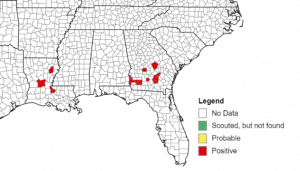
While southern corn rust is the one of the most damaging diseases, be sure it is correctly identified and not confused with common rust. The characteristics that differ between the rusts are the location, color, shape, and distribution of pustules (see table and images 2 and 3). When in doubt don’t hesitate to contact your local county agent for advice on disease management and identification.
Table 1. Comparison of Southern and Common Rust
| Pustule Characteristics: | Common Rust | Southern Rust |
| Location | upper and lower leaf surfaces | primarily upper leaf surface |
| Color | brownish, red | orange to light brown |
| Shape | elongated | round |
| Distribution | scattered | densely packed |
| Other differences: | ||
| Optimal Temperature | 61-77 °F | 77-82 °F |
| Probability of Effecting Yield | low | moderate to high |
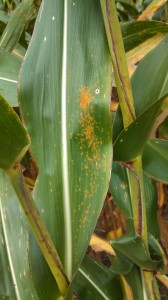
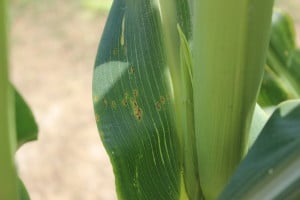
While physoderma brown spot is not of extreme concern, on the leaves (reports I have gotten); it is of concern if it gets on the stalk and causes rot. It is easily identified by the dark spots in the mid-rib of corn leafs (image 4).
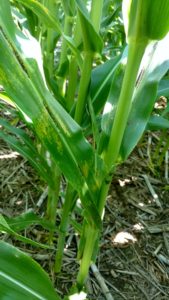
Grey leaf spot (image 5-6) could still warrant a fungicide application in certain situations, but this on a field by field basis.

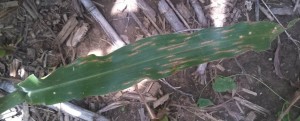
Consider the major factors for disease to develop, have significant effect on yield, and become a significant PEST.
• Pathogen presence – influenced by field history
• Environment – the right conditions for disease to develop
• Susceptible host – a variety that is susceptible to disease
• Time – regarding the growth stage of the plant and when the disease develops
Foliar fungicide applications in corn is more likely to provide a response in yield when disease is present or there is significant risk of disease, weather conditions favor disease development, the field is corn after corn, and a disease susceptible hybrid is planted. Research data from University of Tennessee and other universities has continuously found these factors to strongly influence the magnitude and consistency of yield response to a foliar fungicide application in corn. One can find the corn fungicide efficacy table at UTcrops.com (Corn Fungicide Table) to better pair fungicide with particular targeted diseases when fungicide is warranted.

